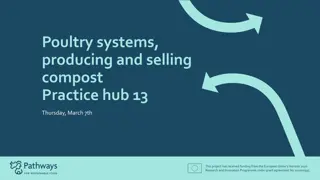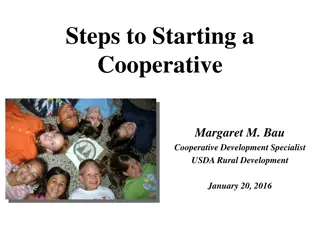
Pathways to a Cooperative Market Economy by Erik Olin Wright
Explore the analytical strategy and logic of transformation towards a cooperative market economy through tasks like normative foundations, diagnosis of capitalism, alternatives, and transformation. Understand the role of democracy in institutional design and the challenges faced by workers cooperatives in creating a democratic economy.
Download Presentation

Please find below an Image/Link to download the presentation.
The content on the website is provided AS IS for your information and personal use only. It may not be sold, licensed, or shared on other websites without obtaining consent from the author. If you encounter any issues during the download, it is possible that the publisher has removed the file from their server.
You are allowed to download the files provided on this website for personal or commercial use, subject to the condition that they are used lawfully. All files are the property of their respective owners.
The content on the website is provided AS IS for your information and personal use only. It may not be sold, licensed, or shared on other websites without obtaining consent from the author.
E N D
Presentation Transcript
PATHWAYSTOACOOPERATIVE MARKETECONOMY Erik Olin Wright University of Wisconsin Madison June 2017
FOUR TASKS 1. Normative foundations 2. Diagnosis and critique of capitalism 3. Alternatives 4. Transformation: how to get form here to there.
Analytical strategy I The economy as an ecosystem of loosely articulated structural forms: capitalist, cooperativist, statist, domestic, etc.
ANALYTICALSTRATEGY II THEGAME RULESOFTHEGAME MOVESINTHEGAME
LOGICOFTRANSFORMATION Change rules of the game so as to allow new moves in the game which have the character of expanding alternative economic structures which endogenously generate further changes in rules of the game. Longterm trajectory: erosion (and potential displacement )of the dominance of capitalism
Task 3 Alternatives
Introduction Democracy as the central principle of institutional design for transcending capitalism: Democratize the economy Democratize the state Democratize civil society
Introduction Do workers cooperatives really contribute to creating a democratic economy?
Introduction Basic problem: Cooperatives remain privately owned, profit-oriented firms competing in markets. 1. Competition creates cost-cutting pressures and neglect of negative externalities. 2. Private ownership by their members generates insider-biases. 3. Private appropriation of profits gives advantages to high skill, high tech cooperatives.
Introduction Basic problem: Cooperatives remain privately owned, profit-oriented firms competing in markets. 1. Competition creates cost-cutting pressures and neglect of negative externalities. 2. Private ownership by their members generates insider-biases. 3. Private appropriation of profits gives advantages to high skill, high tech cooperatives.
Introduction Basic problem: Cooperatives remain privately owned, profit-oriented firms competing in markets. 1. Competition creates cost-cutting pressures and neglect of negative externalities. 2. Private ownership by their members generates insider-biases. 3. Private appropriation of profits gives advantages to high skill, high tech cooperatives.
Introduction Basic problem: Cooperatives remain privately owned, profit-oriented firms competing in markets. 1. Competition creates cost-cutting pressures and neglect of negative externalities. 2. Private ownership by their members generates insider-biases. 3. Private appropriation of profits gives advantages to high skill, high tech cooperatives.
Introduction Response 1. Worker cooperatives directly eliminate one aspect of the democratic deficit in capitalism: workplace dictatorship. 2. Worker cooperatives foster a more democratic culture. 3. Worker cooperatives are geographically rooted and thus easier to regulate by a democratic state.
Introduction Response 1. Worker cooperatives directly eliminate one aspect of the democratic deficit in capitalism: workplace dictatorship. 2. Worker cooperatives foster a more democratic culture. 3. Worker cooperatives are geographically rooted and thus easier to regulate by a democratic state.
Introduction Response 1. Worker cooperatives directly eliminate one aspect of the democratic deficit in capitalism: workplace dictatorship. 2. Worker cooperatives foster a more democratic culture. 3. Worker cooperatives are geographically rooted and thus easier to regulate by a democratic state.
Introduction Response 1. Worker cooperatives directly eliminate one aspect of the democratic deficit in capitalism: workplace dictatorship. 2. Worker cooperatives foster a more democratic culture. 3. Worker cooperatives are geographically rooted and thus potentially easier to regulate by a democratic state.
13 pathways to a expanding worker cooperatives
Autonomous startups 1. Worker-cooperative startups in which a group of people come together to form a cooperative from scratch, getting loans from banks or through social networks. 2. Messy survival strategies of people in desperate conditions who form improvised quasi-cooperatives without a long-term model. Sometimes these adaptations consolidate into cooperatives; sometimes not. 3. Cooperatives develop in a regional economy out of artisanal production and gradually develop networks and other institutions to sustain cooperative firms over time.
Autonomous startups 1. Worker-cooperative startups in which a group of people come together to form a cooperative from scratch, getting loans from banks or through social networks. 2. Messy survival strategies of people in desperate conditions who form improvised quasi-cooperatives without a long-term model. Sometimes these adaptations consolidate into cooperatives; sometimes not. 3. Cooperatives develop in a regional economy out of artisanal production and gradually develop networks and other institutions to sustain cooperative firms over time.
Autonomous startups 1. Worker-cooperative startups in which a group of people come together to form a cooperative from scratch, getting loans from banks or through social networks. 2. Messy survival strategies of people in desperate conditions who form improvised quasi-cooperatives without a long-term model. Sometimes these adaptations consolidate into cooperatives; sometimes not. 3. Cooperatives develop in a regional economy out of artisanal production and gradually develop networks and other institutions to sustain cooperative firms over time.
Incubated startups 4. Cooperatives are incubated (and perhaps subsidized) by the state or NGOs 5. Labor union incubation of cooperatives: the incipient union-CO-OP model in the United States Coops breeding coops 6. An existing cooperative or group of cooperatives incubates a new cooperative 7. An existing cooperative splits into two distinct cooperatives
Incubated startups 4. Cooperatives are incubated (and perhaps subsidized) by the state or NGOs 5. Labor union incubation of cooperatives: the incipient union-CO-OP model in the United States Coops breeding coops 6. An existing cooperative or group of cooperatives incubates a new cooperative 7. An existing cooperative splits into two distinct cooperatives
Incubated startups 4. Cooperatives are incubated (and perhaps subsidized) by the state or NGOs 5. Labor union incubation of cooperatives: the incipient union-CO-OP model in the United States Coops breeding coops 6. An existing cooperative or group of cooperatives incubates a new cooperative 7. An existing cooperative splits into two distinct cooperatives
Incubated startups 4. Cooperatives are incubated (and perhaps subsidized) by the state or NGOs 5. Labor union incubation of cooperatives: the incipient union-CO-OP model in the United States Coops breeding coops 6. An existing cooperative or group of cooperatives incubates a new cooperative 7. An existing cooperative splits into two distinct cooperatives
Conversions 8. Conversion of partnerships or small private firms into cooperatives 9. Conversions of privately-owned firms into worker cooperatives in the context of worker-buyouts when the owners retire (ownership succession conversions). 10. The gradual increase in employee ownership through an ESOP (Employee Stock Ownership Plan) and then, eventually, the introduction of democratic governance and conversion to a more cooperative form. 11. The seizure of bankrupt firms by workers empresas recuperadas and running them as de facto cooperatives 12. Worker takeover of bankrupt firm leading to state ownership + leasing to worker self-managed cooperative. 13. Worker buyouts of bankrupt firms with state subsidizes for transitional conversion to worker-owned cooperative.
Conversions 8. Conversion of partnerships or small private firms into cooperatives 9. Conversions of privately-owned firms into worker cooperatives in the context of worker-buyouts when the owners retire (ownership succession conversions). 10. The gradual increase in employee ownership through an ESOP (Employee Stock Ownership Plan) and then, eventually, the introduction of democratic governance and conversion to a more cooperative form. 11. The seizure of bankrupt firms by workers empresas recuperadas and running them as de facto cooperatives 12. Worker takeover of bankrupt firm leading to state ownership + leasing to worker self-managed cooperative. 13. Worker buyouts of bankrupt firms with state subsidizes for transitional conversion to worker-owned cooperative.
Conversions 8. Conversion of partnerships or small private firms into cooperatives 9. Conversions of privately-owned firms into worker cooperatives in the context of worker-buyouts when the owners retire (ownership succession conversions). 10. The gradual increase in employee ownership through an ESOP (Employee Stock Ownership Plan) and then, eventually, the introduction of democratic governance and conversion to a more cooperative form. 11. The seizure of bankrupt firms by workers empresas recuperadas and running them as de facto cooperatives 12. Worker takeover of bankrupt firm leading to state ownership + leasing to worker self-managed cooperative. 13. Worker buyouts of bankrupt firms with state subsidizes for transitional conversion to worker-owned cooperative.
Conversions 8. Conversion of partnerships or small private firms into cooperatives 9. Conversions of privately-owned firms into worker cooperatives in the context of worker-buyouts when the owners retire (ownership succession conversions). 10. The gradual increase in employee ownership through an ESOP (Employee Stock Ownership Plan) and then, eventually, the introduction of democratic governance and conversion to a more cooperative form. 11. The seizure of bankrupt firms by workers empresas recuperadas and running them as de facto cooperatives 12. Worker takeover of bankrupt firm leading to state ownership + leasing to worker self-managed cooperative. 13. Worker buyouts of bankrupt firms with state subsidizes for transitional conversion to worker-owned cooperative.
Conversions 8. Conversion of partnerships or small private firms into cooperatives 9. Conversions of privately-owned firms into worker cooperatives in the context of worker-buyouts when the owners retire (ownership succession conversions). 10. The gradual increase in employee ownership through an ESOP (Employee Stock Ownership Plan) and then, eventually, the introduction of democratic governance and conversion to a more cooperative form. 11. The seizure of bankrupt firms by workers empresas recuperadas and running them as de facto cooperatives 12. Worker takeover of bankrupt firm leading to state ownership + leasing to worker self-managed cooperative. 13. Worker buyouts of bankrupt firms with state subsidizes for transitional conversion to worker-owned cooperative.
Conversions 8. Conversion of partnerships or small private firms into cooperatives 9. Conversions of privately-owned firms into worker cooperatives in the context of worker-buyouts when the owners retire (ownership succession conversions). 10. The gradual increase in employee ownership through an ESOP (Employee Stock Ownership Plan) and then, eventually, the introduction of democratic governance and conversion to a more cooperative form. 11. The seizure of bankrupt firms by workers empresas recuperadas and running them as de facto cooperatives 12. Worker takeover of bankrupt firm leading to state ownership + leasing to worker self-managed cooperative. 13. Worker buyouts of bankrupt firms with state subsidizes for transitional conversion to worker-owned cooperative.
Public Policies to overcome obstacles to worker cooperatives
1. Unconditional Basic Income 2. Government-funded cooperative training 3. Cooperative development banks 4. Cooperative leasing of publicly owned capital (buildings, land, capital equipment)
1. Unconditional Basic Income 2. Government-funded cooperative training 3. Cooperative development banks 4. Cooperative leasing of publicly owned capital (buildings, land, capital equipment)
1. Unconditional Basic Income 2. Government-funded cooperative training 3. Cooperative development banks 4. Cooperative leasing of publicly owned capital (buildings, land, capital equipment)
1. Unconditional Basic Income 2. Government-funded cooperative training 3. Cooperative development banks 4. Cooperative leasing of publicly- owned capital (buildings, land, capital equipment, etc.)






















